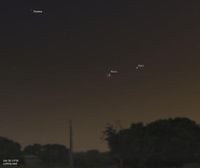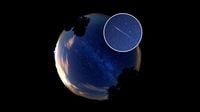Tonight offers a celestial treat for skywatchers as the moon, Mars, and several meteor showers align to create a spectacular astronomical show. On July 28, 2025, the moon is in its waxing crescent phase, with approximately 9 to 16 percent of its surface illuminated, depending on the time and location. This phase marks the fourth day of the lunar cycle, a period when the moon gradually brightens after the new moon, revealing more of its familiar features to observers on Earth.
According to NASA's Daily Moon Observation, only 9 percent of the moon's surface is visible to the naked eye this evening, but even this sliver offers fascinating sights. With the unaided eye, observers can glimpse the Mare Crisium and Mare Fecunditatis—two large lunar maria that stand out as dark, flat plains on the moon's surface. Those equipped with binoculars or telescopes will enjoy a more detailed view, including the Endymion Crater, a notable feature in the moon's northeastern region.
Adding to the lunar spectacle, the moon will pass just 1.3 degrees south of Mars at 4 P.M. EDT today. By sunset, the two celestial bodies will appear horizontally aligned in the western sky, both residing within the constellation Virgo, known as the Maiden. By 9 P.M. local daylight time, they will reach an altitude of 15 degrees, making them visible for approximately two hours before setting shortly before 10:30 P.M.
Mars itself will shine with a magnitude of 1.6 and present an apparent disk size of 4 arcseconds through telescopes. While this size limits the amount of surface detail visible, the Red Planet's presence alongside the crescent moon makes for a captivating pairing. The moon’s eastern limb, illuminated by the sun, will highlight Mare Crisium and several smaller craters within it—Picard, Pierce, and Swift—each contributing to the moon’s textured landscape.
Sky enthusiasts should also look to the upper left of the moon and Mars to spot Porrima (Gamma Virginis), a third-magnitude double star with components separated by about 3 arcseconds. While Porrima is occasionally occulted by the moon, tonight it will be clearly visible, offering a charming point of contrast in the night sky. Tomorrow, the moon will pass significantly below Porrima, standing about 5.5 degrees to its lower left by evening.
As the moon waxes toward fullness, the next full moon is expected on August 9, 2025, following the last full moon on July 10. This 29.5-day lunar cycle, driven by the moon’s orbit around Earth, causes the changing phases we observe—from new moon to full moon and back again—shaped by the shifting angles between the sun, moon, and Earth.
But the wonders of the night sky do not end with the moon and Mars. This week also marks the peak of two lesser-known meteor showers: the Southern Delta Aquariids and the Alpha Capricornids, which will reach their height on the night of July 29 going into July 30. According to Nick Moskovitz, a planetary astronomer at the Lowell Observatory in Arizona, these showers could produce between 20 to 30 meteors per hour under optimal conditions.
Unlike the much-anticipated Perseid meteor shower, which peaks on August 12 but will be hampered this year by a bright, nearly full moon, the Southern Delta Aquariids and Alpha Capricornids benefit from a moon that is only about 25 percent illuminated during their peak. This lower moonlight means darker skies and better visibility for shooting stars.
Meteor showers occur when Earth passes through streams of debris left behind by comets or asteroids, with tiny particles burning up in our atmosphere and producing bright streaks of light. These bits of debris can be as small as grains of sand or dust, yet they create spectacular displays visible to the naked eye.
For the best viewing experience, experts recommend watching meteor showers in the early morning hours, between midnight and dawn, away from artificial light sources. Allowing eyes 15 to 30 minutes to adjust to the darkness enhances the ability to spot faint meteors. Also, turning off cell phones and other screens helps maintain night vision.
Observers in North America aiming to catch the Southern Delta Aquariids should position themselves with an unobstructed view of the southern sky, as this is where the meteors radiate from. The Alpha Capricornids, while less frequent, are known for producing slow-moving fireballs that can be especially striking. These slow fireballs can provide memorable highlights during meteor-watching sessions.
No special equipment is necessary to enjoy these meteor showers, though binoculars can enhance the experience for those interested. Telescopes are generally not recommended for meteor watching because meteors streak quickly across wide areas of the sky. For beginners interested in telescopes, experts suggest models with lenses rather than mirrors and caution against inexpensive options under $500.
Looking ahead, the Perseid meteor shower remains a highlight of the summer sky, renowned for its bright and numerous meteors. Although the full moon on August 12, 2025, will dim the display, the Perseids are still worth watching. Next year promises an even better show, with predictions of an outburst—an unusually high number of meteors per hour—coinciding with a dark moon, making 2026 a potentially spectacular year for meteor enthusiasts.
Whether it’s the delicate crescent moon revealing its craters, the subtle dance of Mars nearby, or the fleeting brilliance of meteors streaking across the sky, this week offers a rich tapestry of celestial events. So, find a dark spot, bring a blanket, and look up—there’s a universe of wonders waiting just above.


